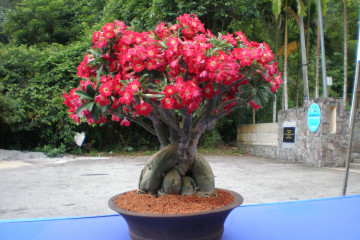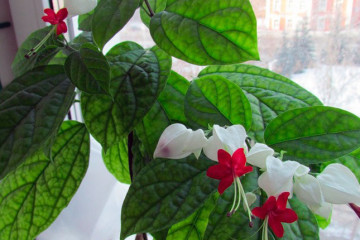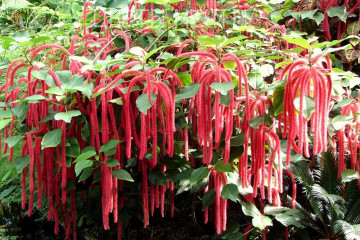Adenium flower - home care
Content:
Such a chunky flowering baobab like adenium will become a real exotic accent of the interior. The appearance of this plant is eye-catching, and its flowers are compared to a rose. It combines two incompatible features - a bare trunk and lush large flowers.
What does adenium look like, which family does it belong to

He is loved for his extraordinary appearance.
The countries of Central and South Africa are the birthplace of adenium. The succulent belongs to the Cool family.
Depending on the shape, the adenium plant can be in the form of a bush or a tree. The trunk is branched, thickened at the base. Leaves grow mainly at the ends of the shoots, lanceolate, pointed or obtuse. The surface of the leaf is velvety or glossy, the color is mainly juicy green. Some varieties are variegated, with white-yellow or red-black stripes. The shoots become brown and denser over time.
Common varieties
There are only nine varieties of adenium. The most popular and unusual ones:
- Obsession, or obese adenium. Most adapted to indoor growing, therefore it is popular among florists. Stems are wide at the base and narrowed at the ends. The foliage is glossy, oblong in shape with a sharp or rounded top. Flowers are of the most varied shapes and colors.
- Oliefolium. Its unusual elongated leaves seem to be collected in a rosette at the end. Foliage color - light green, with a matte white bloom. The flowers are simple in shape and have five petals. A palette of shades - from dark purple to light pink.
- Multiflorum, or multi-flowered. The fastest growing shrub. Favorable care allows you to get a medium-sized tree (up to 3 m) from a multi-flowered species. The foliage is large, dark green. Flowering deserves special attention - it is abundant and colorful. Flowers - light pink with a smooth transition to dark pink along the edging of the petals.
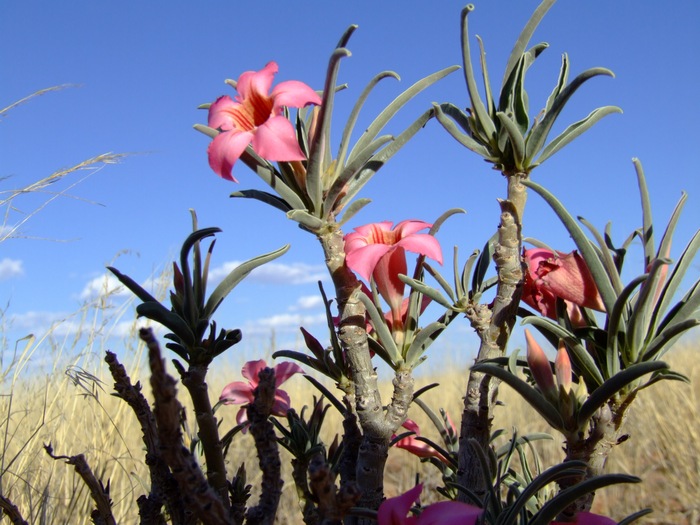
Oliefolium species
All varieties have almost the same growth and maintenance conditions, and they adapt quite easily to apartment conditions.
Briefly about the history of appearance
For the first time, the plant was collected in an area called Adena, which is why the flower was named with this name. Translated from African dialects, adenium means “desert rose”. Botanists gave a botanical description of the culture back in 1819.
Features of caring for a plant at home
In caring for an unusual exotic, it is important to preserve two conditions of detention - an abundance of light and warmth. When it comes to moisturizing, you should find an approach to each plant individually. A feature of adenium is a thickening at the base of the trunk - caudex. It is a pantry of moisture and nutrition. Excess water leads to decay and the development of fungal diseases.
Temperature
Hot summers are ideal for adenium.A temperature of 25-30 ° C will promote vigorous growth and flowering. But it is important to keep the appropriate level of heat in the fall and spring. Adenium does not like temperature changes, drafts and cold windowsills. In winter, the plant has a rest mode. The temperature during this period is 10-15 ° C.
Lighting
A south or southwest window would be a great option for growing exotics. Bright sunlight is prescribed for adenium. He is afraid of direct sunlight only if they hit the foliage for more than 5 hours during daylight hours. At the exit from the dormant mode, the plant is gradually taught to light.
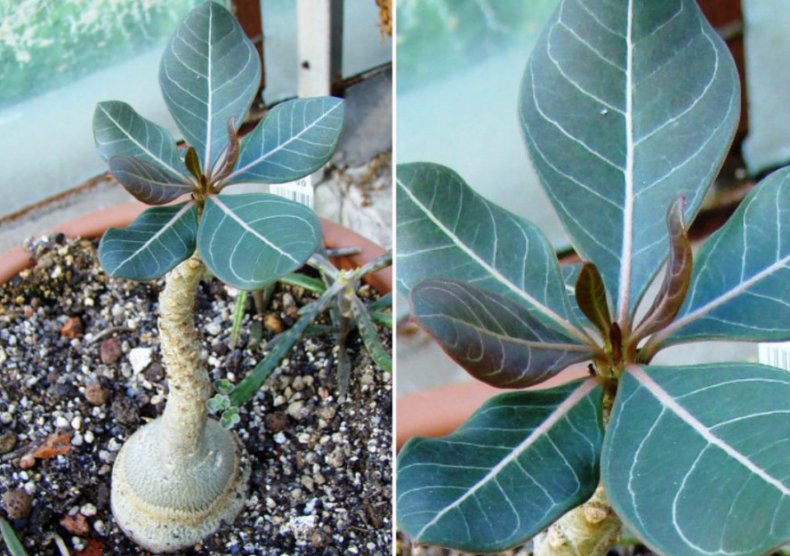
The more light, the richer the color of the foliage
Watering
Water the flower after the soil in the pot is completely dry. You can check the state of moisture with a wooden skewer. The water should be warm and settled. During the dormant period, the plant practically does not need watering: it should be scarce. During the awakening of the flower, it is moistened two weeks after the appearance of young buds.
Spraying
The bush should be sprayed during a warm period, creating a cloud of moisture around the crown. When spraying, it is important not to get on the flower petals.
Humidity
The exotic has no special requirements for humidity. But too dry air, especially in winter, will not do him good.
Priming
The soil mixture should be very light and loose. For this, sod and leaf land in equal amounts is diluted with coarse sand, vermiculite, perlite, and small stone.
It acts not only as a nourishment, but also counteracts the formation of fungi and pathogenic bacteria in the soil and on the roots.
Top dressing
With a very weak solution of complex fertilizer (1.5-2%), the adenium flower is fed once a month from the beginning of active growth until mid-autumn.
Features of care in winter, dormant period
Winter rest works for:
- abundant flowering for the next season;
- intensive laying of leaf buds;
- plant restoration.
When adenium sleeps, home care should be as follows:
- temperature - 10-15 ° C;
- lighting - partial shade;
- watering is very rare;
When and how it blooms
Adenium flowers bloom in early spring or autumn. Some species are capable of blooming at any time of the year. Buds appear along the entire length of the stems and even on bare areas.
Types of flowers
Flowers are simple - from five single-row petals. Or terry, stuffed.
Flower shapes
The shape of the flowers is similar to lilies, roses or daisies. Some varieties have tubular flowers.
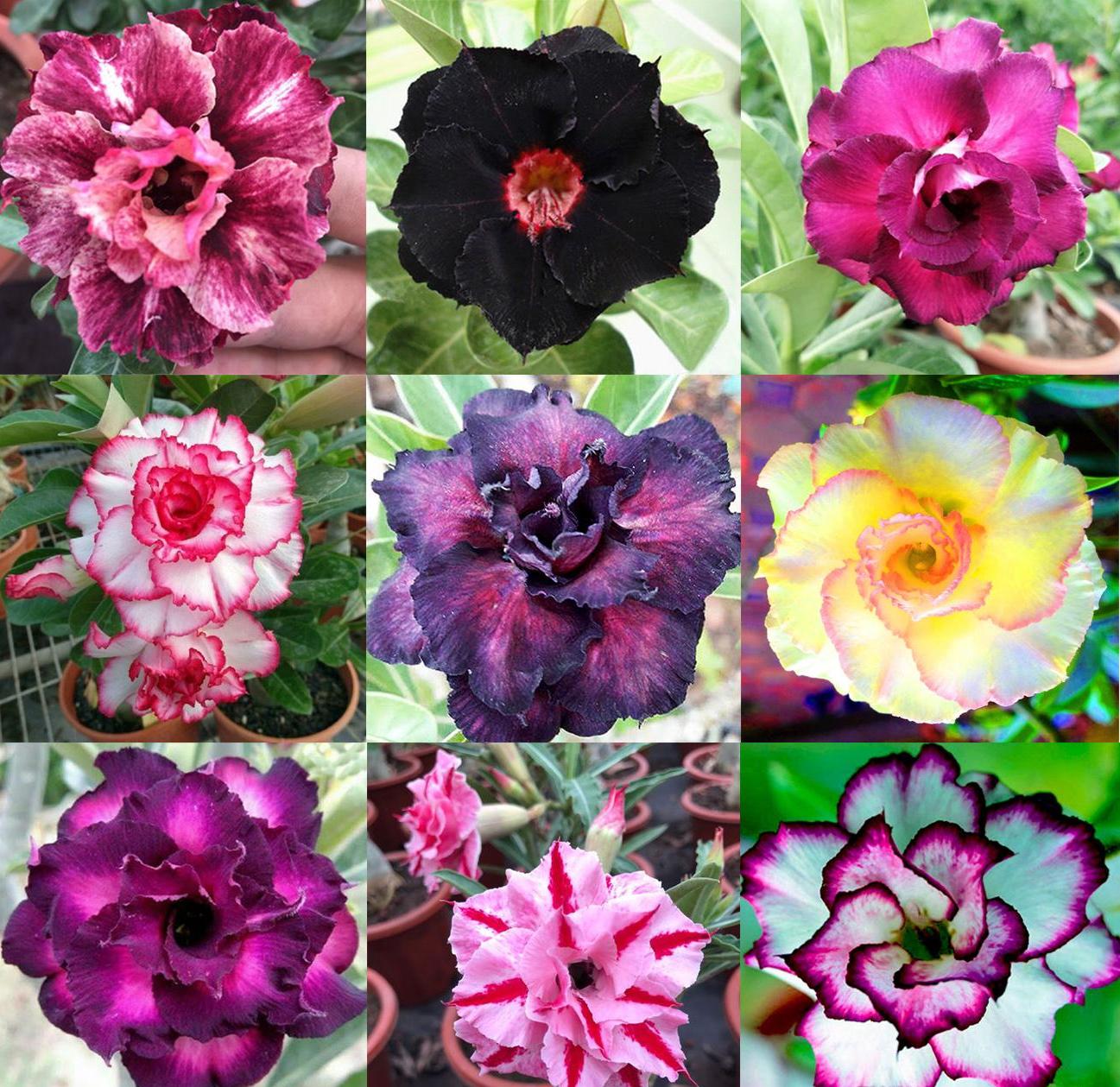
Variety of shapes and colors
Flowering period
Already adult specimens bloom for 3-4 years of life.
The buds ripen within a month.
Changes in care during flowering
Many indoor flowers require additional complementary foods or increased lighting during budding and flowering. How to care for adenium when it has laid the buds? If the flower has thrown away the buds, it means that it is comfortable and it suits everything in the current care. A change in the place of growth, lighting or recharge can provoke a drop of flowers. The only thing you can pay attention to is hydration. During the flowering period, you can slightly increase the volume and frequency of watering.
Pruning
The trimming procedure allows you to:
- form the desired crown for the plant;
- update the green part of the flower;
- provoke abundant flowering;
- rejuvenate the flower.
This formation allows you to radically change the appearance of the flower. He quickly grows new shoots, strewn with leaves.
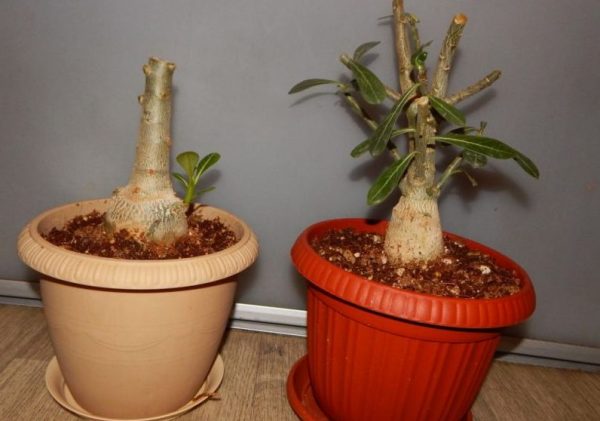
After trimming
How adenium multiplies
There are several problems with the reproduction of adenium. Growing its seeds is a rather painstaking task. The plant grows slowly and reaches standard sizes after a few years. In the propagation of adenium by cuttings or layering, it is important not to fill it, since the cuttings then quickly rot.
Germinating seeds
Sowing period - late winter, early spring. The seeds are soaked in a growth activator before planting. They are planted immediately in the soil for an adult plant: loose and breathable. The most important condition for seed germination is that the soil temperature should be in the range of 30-35 ° C. At this level, it must be maintained on an ongoing basis. The light level is not important for the seed.
On the 7-10th day, sprouts appear. When they get stronger and acquire several pairs of leaves, they can be transplanted into a more spacious container.
Rooting cuttings
Cuttings are cut in the spring after flowering. Cut branches need to be treated with charcoal and allowed to dry. Cuttings can be planted directly into a ready-made substrate or a mixture of sand and peat. It is important to moisturize young twigs moderately and with care - the cut site quickly decays.

Cuttings of adenium
Air layering
Layers can be obtained in the following way:
- A thick shoot (at least 2 cm in diameter) is chosen and a circular incision is made on it.
- To speed up the process, the incision site is treated with a growth stimulant.
- Wet sphagnum moss is wound around the cut on the trunk, securing it with a film or bag.
- Sphagnum is moistened as it dries.
Already 3-4 weeks, roots appear and the shoot is ready for transplantation. You can quickly and easily propagate an exotic in this way. The young plant feeds on the mother plant and grows stronger. Such cuttings can bloom next year.
Graft
Another adenium or oleander is used as a scion. The graft is cut almost to the root, leaving a convenient "stump" for the rootstock. A longitudinal incision is made. Side cuts are made on the rootstock so that the cuttings fit well into the cut. Further, the plants are firmly fixed with a cloth or film. You can use special preparations for the reliability of the procedure.
The plant is removed from the window away from direct sunlight. But abundant lighting is necessary for such reproduction. The optimum temperature is not lower than +30 ° C. You also need to provide the culture with high air humidity. New shoots on the scion must be plucked for the grafting to be successful.
Adenium transplant
At home, for a young growing bush, you need to change the pot and soil every season, in the spring. An adult plant is transplanted as needed: when the pot has become small, or the plant has stopped growing and stopped blooming.
Before transplanting adenium, it will be correct to choose a pot in advance. It is important to take into account the peculiarities of the growth of the root system. It grows in breadth, not in depth. Therefore, the pot should be chosen wide and shallow. Since it stands in the bright rays of the sun, you should not choose dark colors of the container: this will overheat the soil inside. Better to take containers made of clay.
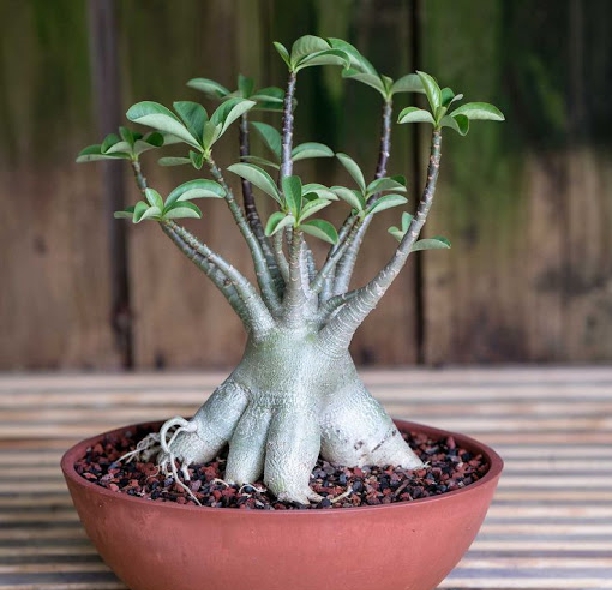
An example of a suitable pot
Drainage should be installed in a thick layer and holes should allow air to pass into the soil. The transplant soil should not be wet. The first watering after the procedure is carried out no earlier than a week later.
Possible growing problems and diseases
If the conditions of detention are not suitable for a resident of hot Africa, the plant will quickly lose its decorative effect and die.
Drops buds and leaves
Discharge of buds can occur from a sharp change in conditions of detention after the release of buds.This point concerns lighting, temperature, watering, complementary foods and the place of growth. The foliage falls off when drafts appear or the temperature drops. Sometimes cold window sills or window glass are to blame for this behavior.
Leaves turn pale
Disruption of photosynthesis or chlorosis of leaves occurs due to jumps in the content of certain nutrients in the soil. For example, with a lack of iron, the leaves not only lose their color, but can also symbolize the beginning of the process of rotting of the root system.
When watering with hard water, an excess of calcium is formed in the soil. It changes the acidity of the soil, leading to a deficiency of all trace elements.
The solution to this problem will be an emergency resuscitation of the flower in a new soil.
The tips of the leaves dry
The tips of the leaves dry out when the soil dries out or when the air is too dry (if the pot is near heating devices). A marginal burn can form in the absence of potassium in the composition of complementary foods.
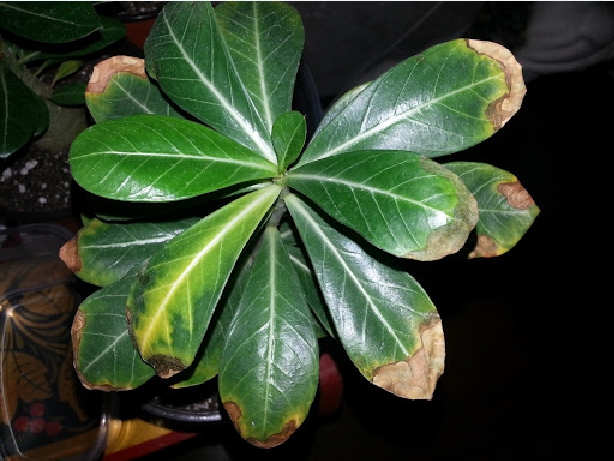
Lack of nutrition provokes drying out of foliage
The lower leaves fall
In the autumn, before sleeping, the flower actively sheds the lower leaves, which rapidly turn yellow. This is a natural process and after a properly organized rest regime, adenium will grow its greenery.
If the discharge of the lower leaves does not occur according to the schedule, but in a different period, you should pay attention to the state of the remaining leaves. If young leaves began to grow small and with a red-yellow tint, then the reason is a lack of complementary foods. The plant lacks nitrogen, which is precisely responsible for the growth of green mass.
Pests, viruses
The most inveterate pest is the spider mite. He settles in warm and arid places. There is a high probability of picking up this parasite in the summer, if you take the pot out into the garden. It is very difficult to identify it at the initial stages of the population. This is a small insect that cannot be seen with the naked eye. You can determine the presence of a spider mite by the cobweb, which is clearly visible after spraying the plant.
Getting rid of a tick is even more difficult than detecting. And all because it develops immunity to insecticides and dies only after several treatments. The interval between them is 5 days.
The rest of the pests settle on the plant in conditions of high humidity and high temperatures. These are aphids, nematodes, mealybugs or scale insects. They all get to the plant from the same garden in the summer, or from the soil that was not disinfected before planting. You can get rid of parasites by treating them with appropriate drugs.
Signs and superstitions
Many are afraid to breed adenium, as this flower is poisonous. Yes, the plant sap is toxic and can cause allergic reactions and burns if it comes into contact with the skin. Therefore, when performing manipulations with it, it is important to protect yourself and protect your skin. Placing a tree in an apartment, you should protect access to it for children and pets. The rest of the handsome man has no contraindications on the part of superstitious people and lovers will accept.
An unusual, unusual, exotic plant is worthy to settle on the window of an amateur florist. The popularity of adenium is only gaining momentum. Its decorativeness is worth it to build comfortable living and care conditions for it.

